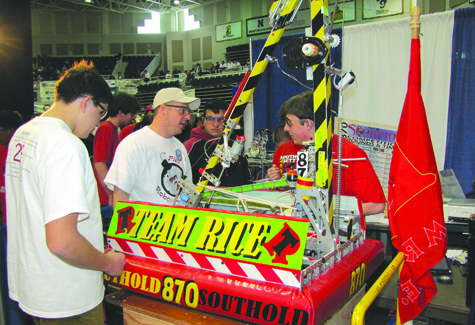Southold places in top 10 at Hofstra regional robotics competition

A group of high school students with green mohawks carefully carried a 6-foot-tall robot to an inspection area in Hofstra University’s stadium Saturday.
Some students dressed in blue body suits and skirts scrutinized their robots, ensuring they were in working order.
Others held onto their purple wizard hats while driving their robots with joystick controllers. Pop music blaring from a DJ’s speakers was drowned out at times only by the whooping of a crowd of fans in the stands.
One lively group of students held up posters with giant red letters spelling out SOUTHOLD.
Such was the scene of the Long Island Regional FIRST Robotics Competition, where students unleashed robots they built and programmed to battle it out on the stadium floor. Southold High School’s Team RICE — Respect, Impulse, Compassion and Equity — ranked eighth out of 50 schools.
“We were looking to be in the top 10,” adviser Tony Kryl said. “It was a lot of work. We pushed hard and we were able to do it.”
The Southold team is in a rebuilding year, Mr. Kryl said, explaining that he had about 15 new members and five seniors.
Another of their goals was to be able to assist other teams, and Southold did so by helping the freshman team from Hampton Bays. It worked: the Baymen took the highest score for a rookie team, Mr. Kryl said.
Southold competed in New York City two weeks ago as a warm-up to the regional competition at Hofstra. The team was seeded eighth out of 66 and reached the semi-finals in both competitions before being eliminated.
At the New York City competition, Southold took home an award for the quality of their robot, a machine Mr. Kryl described as “phenomenal.”
This year’s game involved placing symbols — a triangle, circle and square — on racks of various heights. The competition consisted of two-minute and 15-second matches.
Southold’s robot was the culmination of six weeks of designing, building and programming, with students often working from right after school until 11:30 p.m., Mr. Kryl said. They produced a robot with an excellent maneuvering ability, he said. Students installed a mechanum drive, a system that allows the robot to move in any direction without turning its wheels. They also equipped the robot with a double articulated claw designed to grab with speed and accuracy.
Robotics club students sitting in the stands played a crucial role in the team’s success, scouting other robots to identify their strengths and weaknesses, Mr. Kryl said. Reports from Southold students and parents help the team of four operators develop strategy.
Emma Romeo, 16, watched intently as her team’s robot made it to the quarterfinals and then semifinals, where they lost by a narrow margin.
“It can be really frustrating because you have no control over what your driver is doing,” she said.
Sam Kortchmar, 16, one of the operators, hoped to make it to the finals but was still happy with his team’s performance.
“We really did have one of the best robots out there,” he said.
Robotics club alumni Tyler Mehrman, 19, came to the competition to support his former teammates. The club steered him into majoring in aerospace engineering at Massachusetts Institute of Technology, where he is currently studying.
Though the spirit of the competition mirrors sporting competitions, robotics is a unique entity, Mr. Mehrman said.
“It’s completely different than anything else in high school,” he said. “You get that kind of excitement, sportsmanship and ingenuity in technology, engineering and computer programming, which is the future of the world, which is what people really need to get excited about.”








